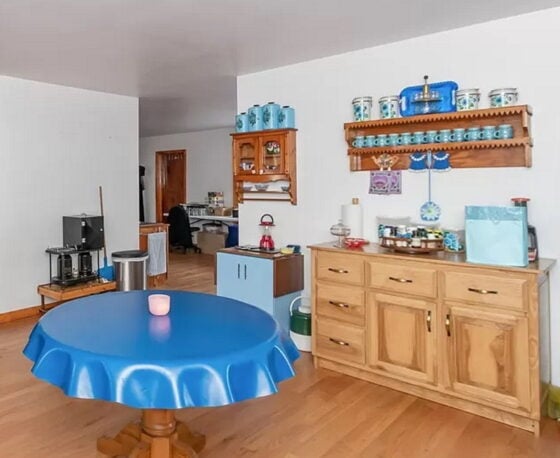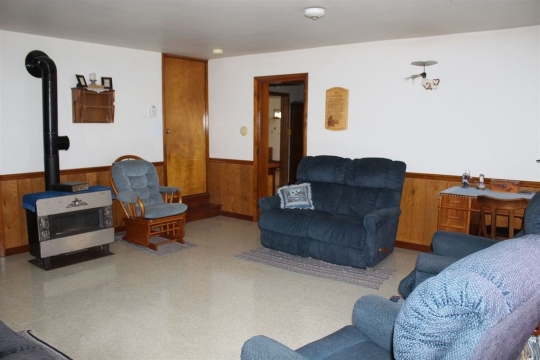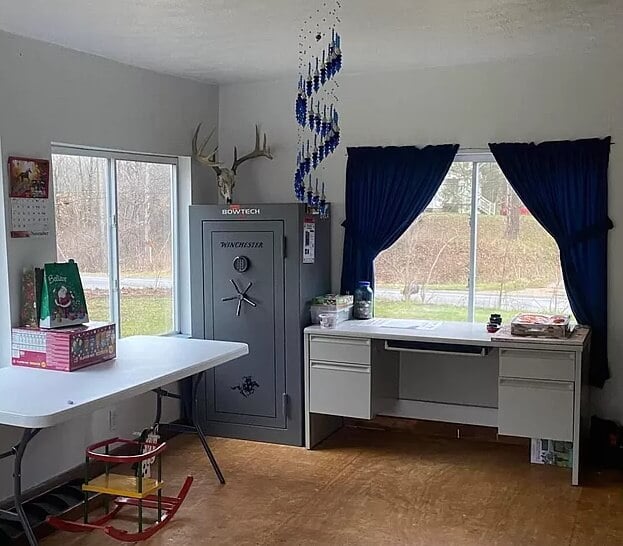Look Inside A New York Amish Home (12 Photos)
From time to time we see Amish properties up for sale online. Two such homes appeared in Ohio and New York.
Comparing those two cases, you can see how different Amish homes can be.
The Ohio home is from a New Order Amish church. The New York home is from a Swartzentruber community. They are quite different inside (and outside, for that matter).

Now we get some photos from another New York home (via Syracuse.com; all photos by John Thomas of Lightsong Photography).
This one is from another rather conservative Amish tradition – the Troyer Amish. This interior would be more like the Swartzentruber home.
This abode is located in Conewango Valley in western New York.
It’s a small home on a small property (about 1300 square feet, “1+” bedroom, on about 1.5 acres). Maybe owned by a young family, childless couple, or older couple?
The price? $44,900.

Why is the home online? You’d first think the owner would easily find a buyer within his own community.
This is a large community (15 church districts) with a good number of new families coming up all the time.
The home lacks public electricity lines (as well as indoor toilets, as is the norm in this group) – seemingly ready-to-go for another Amish family to move in.
Perhaps they wanted to maximize the potential price they might get by reaching outside buyers?
The Syracuse.com article (which sounds more like real estate sales text) tells us that “The possibilities are endless for this nice property. It can turn into a cool artist retreat, a house in the country, or just a place to live off the grid.”

Or…could it be that the owners are no longer with their church?
If they are in the Bann, then that means not doing business with church members in good standing.
We’re told that the sellers do woodworking and quilting, and not much more info than that.
I guess that mystery will remain for now.
For us it’s an opportunity to see what the interior of a home in this Troyer Amish community is like.
You can view the full agent listing here (listing removed). I’ve shared some of the more interesting photos below.
What do you notice?
The kitchen.

Weaving room.

The bedroom.

Another view of the kitchen.

Wash area inside the barn.

Also inside the barn.

The attic.

The workshop.

And we close with another view of the weaving room.











Nice home
It is educational to view different cultures and their lifestyles.
Weaving Room
That’s not a loom, it’s a quilting frame.
A more general term for the room might be “craft room” if you’re English, or maybe “sewing room” if you’re Amish.
But it’s interesting to see the different culture.
Right, it is a quilting frame.
The photo source captioned it as “weaving room”, so that’s what I used as well.
Maybe that is how the owners call it (a regionalism?), or maybe that is just a misnomer that the paper came up with.
Location is troublesome
I know this home/location … I drive past it several times a week.
The lot itself is small, compared to the nearby farms that lie next to, and wrap around the back. It’s also near the northern end of the community, and is not as central (geographically speaking) to the community as a whole. Lastly, there’s a county roads department garage and materials storage facility nearby on the other side of the road, and I can’t imagine it’s not a noisy distraction to a plain home life.
Interesting, thanks for the extra info James. Maybe that last detail you share is why this home is getting marketed beyond the Amish community.
I’m fascinated by those super-shiny ceilings!
I totally missed that Adair! I think you could see your reflection in them.
Shiny ceilings
Would reflect light better too!
Is that a towel bar in the bedroom window? Great idea.
Nice comfortable and moblie office chairs around the quilting frame.
A cook stove in the workshop. Also smart. Bake a pie and do some work at the same time.
I see lots of blue. Blue doors and curtains and quilts. Almost like the Nebraska Orders in Mifflin County, PA. I would love to see their buggies.
All Amish seem to like the old style Maytag washing machines.
Thanks for sharing.
Sunny and Bright
The thing that impressed me about the photos was the brightness of all the rooms used for social and private events – the bedroom, the kitchen, etc. None of the Amish homes I’ve visited – which is not a few – here in Wisconsin are not painted as brightly with high gloss enamel. My Amish friends relegate bright colors to bed covers (quilts) only, not walls or trim around doorways and windows.
I’m not saying that this is bad…or good; just different. Different strokes for different folkes – and all that!
All I know is: Amish are the best kind of people in the world.
Amish people
I agree and disagree that the Amish are the best people. They are helpful, very polite, non aggressive, kind people… EXCEPT (I dont know about the NY and OH populations) The Pennsylvania Amish are the main operatorss of Puppy Mills. I think by now we all are in agreement that Puppy Mills should ALL be shut down.
Overall I appreciate the general openness and simplicity in Amish homes. I’ve got too much clutter in my own home right now, so this is a good reminder to start tossing some stuff:)
Durable Paint
While the brilliant sky-blue color will vary in use by different Amish groups, it’s been my understanding that the tough covering of high gloss enamel paint is used to protect the areas of the home that will take the most “pounding” in daily life. Surfaces such as baseboards, that will take the hit from furniture, such as the wheels of constantly moving wheels of those office chairs, feet, children’s toys, particularly when MANY are all wood. Also the door and window frames, to protect from the buildup of handprints from constant use in certain areas, all of which are made much easier and quicker to clean with a quick wipe with whatever acceptable cleaning solution and a sponge or a rag.
I’m not sure about the presence of those extremely shiny ceilings though! Maybe they would cut down on the buildup of cobwebs since the surface is so slick? Just a guess, actually. I noticed too, that in the kitchen area, there doesn’t appear to be a sink? If there is, I guess I missed it, but with the lack of actual plumbing pipes and fixtures, perhaps it’s managed another way? A dry sink that isn’t actually immediately visible?
As for the old fashioned Maytag washing machines, Maytag, as I understand it from other sources, is the lone holdout manufacturer that still produces that style of washing machine that is operated by a gasoline motor, not requiring electrical connection to operate. The same style that used to be seen on farms, and in homes in city and town basements, during the 20’s, 30’s, 40’s and so forth. So, they need a wringer to remove the wash and rinse water, since they only agitate and drain, without the use of a spin cycle to remove water by centrifugal action. All you need is some gasoline to power the motor, started with a kick pedal, which also means if you care to, you can wheel the washer out on the back porch, if you don’t want to drain everything down a dry well, or some other receptacle for the used up wash and rinse water. It can make it more portable, if you’re so inclined!
Washing machine...
After looking over the photos provided by the real estate agent, I find myself needing to clarify a couple of things from my first comment. Particularly dealing with the washing machine, and with the kitchen “sink.”
Regarding the “washing machine,” I find that, after taking a more detailed look at it, it doesnt appear to actually be any kind of a “machine,” after all. It looks like a double tub, or wash tub, with a wringer device sitting on the middle portion between the two tubs. (The second tub is sitting directly behind the front tub.) There’s no agitator mechanism at all, and likely is just a plain tub, with a drain hose attached underneath the tub in the front, and likely has another drain hose under the back tub as well. It looks like theres a garden hose strung up across the wall up high, which might be the source for the cold water for the wash tubs. The wringer most likely operates manually somehow, to remove the water from the fabrics. How do the clothes get washed? Probably just the real old fashioned way, with a wash board!
As for the kitchen sink, there seems to be some kind of large aluminum sink sitting in the top of a blue cabinet base of some sort, as seen in one picture, and may have some sort of hose bib, or faucet of some kind. On my phone, the picture isn’t terribly clear. But, blowing it up a little helps a little bit.
Sorry about the confusion, but that’s what happens to me when I jump the gun without getting more of the details first, before I open my yap!!
Now, what I SAID about Maytag washing machines still applies – but, it just doesn’t apply HERE!
Maytag
The washing machine is the one on the right. The wringer can be swiveled around to wring out the washed clothes in the rinse tub.
Marcus Yoder
Clarification
Thank you very much, Marcus, for the clarification on the placement of the washing machine versus the rinse tub. I appreciate it.
maytag
I have a couple of these older maytag washers. The wringer with the gear box will pull straight up and off, so you can put a meat grinder on. There is also a butter churn that can go in place of the agitator. I think there might have been some other attachments also.
Marcus Yoder
Shari just to throw in my two cents on the sink question, this would be a group of Amish who don’t have running water/plumbing in the home, so you won’t see the traditional sink as you would in most Amish homes. I was just in a home in another community of this group of Amish in Mississippi a last month. They are quite sparse and pleasantly simple interiors, though personally I wouldn’t last long without a steady hot water source!
The old Maytag...
The old machine you see was certainly, a Maytag. The tub on the left housed the soapy water, and the tub on the right was your rinse water. The way the clothes were done was they first went into the wash tub,and got scrubbed on a washboard. Then, before the clothes went into the rinse, they were wrung through the wringer (to get all the soap suds out); then, they were put through the rinse and allowed to sit until someone (usually the same person) decided to agitate them, squeeze the rinse water out of them and then, they were run through the wringer for a final time before being taken outside and hung on clotheslines.